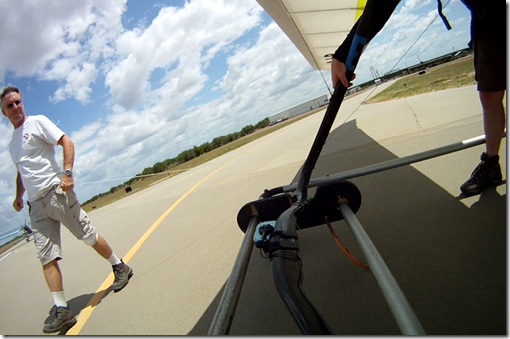That's a bit odd Stuart. 'Cause earlier on this page you say:TowMeUp.Com - 2012/04/27
If you happen to tow with us on one of our towboats, you would notice we almost always have a pair of links tied from 250 pound test line and another from 300 pound test line. The smaller links break at around 264 pounds and are used by almost all solo pilots.
One weaklink does not work for all pilots.
Most reliable sources believe that a weaklink should be sized so that it breaks at 75% to 100% of the inflight load.
So I don't think it's unreasonable to assume that you're towing flying weights from 150 to 250 pounds on the same 264 pound weak link.Light pilots need weaklinks that break with a lower force than heavy solo or tandem pilots.
So that means a G range from a little over one G for the big guys to one and three quarters for the wee folk.
Are your bottom end reliable sources OK with you going over double - a full G over - what they believe a weak link should be sized to for the women and children? I always thought those were the ones who got FIRST pick of the lifeboats.
This is really most confusing.
Who gives a fuck about the tandems? We'll probably hafta sacrifice a student but at least you'll get taken out at the same time.The larger link breaks at around 384 pounds and is used for tandems.
- Sounds like crap. I haven't seen that testing Dacron.The links are all the same length when tied which we use to tell if a link has had a transient overload applied. Lets say on the previous tow the pilot had an overload situation occur that dramatically stretched the link, but didn't cause it to blow out. This will be obvious when the next pilot is hooked up for the tow, as the overloaded link will be an inch or 2 longer than the others. We simply cut it off, use the other link for the tow, and replace the link when the drogue is rewound for the next tow.
- So what you're saying is that when the glider's pulling to almost the limit of what you've deemed maximum safe tow tension nobody on the surface or glider is having any problems or even noticing anything going on. (Big surprise.)
For those APPLICATIONS where a pilot elects not to use any type of safety link?Leader Lines are typically short lengths of spectra with sewn eyes on both ends. Typically they are connected between the apex of the drogue chute and the weaklink clip in link. Leader lines serve 2 functions. Primarily they are used to add space between the drogue chute and the pilot. In the event that tow tension is reduced in flight, the drogue chute will inflate. The use of a leader line ensures this happens well in front to the pilot, rather than in the pilots face. We typically use a leader line of lower breaking strength than the towline and use it as a "backup" weaklink for those applications where a pilot elects not to use any type of safety link. Our sewn leader lines are available in 6 - 8 foot lengths in the following breaking strengths. 825 Lb., and 1800 Lb breaking strengths.
You mean "applications" like towing paragliders?
"Applications" where a pilot ELECTS not to use any type of safety link?
So what kind of irresponsible asshole ELECTS to tow some other irresponsible asshole who's too stupid to use ANY safety link?
Oh, right. You DO use a safety link - an 825 or 1800 pound length of Spectra. Reasonable compromises with the seventy-five to a hundred percent limit most reliable sources believe to be appropriate.
So let's do the math for those applications where a pilot elects not to use any type of safety link.
Three and a third to five and a half Gs. Sounds like a plan to me!
Let's not even bother with the eighteen hundred pound stuff. We went off the deep end a long time ago.
Why don't you just put everyone up at one and a half to two Gs and stop writing all this lunatic crap?
P.S.
How'd your releases do at 825 and 1800 pounds?We are big fans of testing and virtually all of the products on this site are tested to failure to ensure they perform as designed.
Moron.
